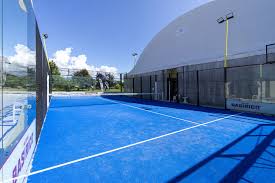

The Rise of Padel Tennis and Its Unique Court Design
In recent years, padel tennis has surged in popularity across the globe, captivating sports enthusiasts with its unique blend of tennis and squash. What truly sets padel apart is not just the game itself, but the distinctive design of its court. Understanding the structure and features of a padel court is essential for appreciating the sport and maximizing the playing experience.
Court Dimensions and Layout
A standard padel court is a rectangular space measuring 20 meters long and 10 meters wide. This smaller dimension compared to traditional tennis courts (which are 23.77 meters long and 8.23 meters wide for singles) allows for a more engaging and quick-paced game. The court is enclosed by walls made of glass and solid materials, which players can use strategically during rallies, similar to the bounce in squash. This enclosed design not only creates a unique playing atmosphere but also enables continuous play, as the ball can rebound off the walls, adding an additional layer of strategy.
Surface and Lighting
The playing surface of a padel court is typically made of artificial grass or a special acrylic material. These surfaces provide excellent traction and allow players to move quickly and fluidly. Most padel courts also come equipped with adequate lighting for evening play, as the sport is enjoyed both day and night. The illumination should be evenly distributed to ensure visibility and enhance the playing experience.
The Enclosure Wall Design and Function

The walls that comprise a padel court are a key feature that distinguishes it from other racquet sports. The back walls are often made of tempered glass, which not only provides players with visibility of the game but also creates a dynamic playing space. The front walls are typically solid and can vary in height, but they also add an element of strategy to the game as players can use them to their advantage to outmaneuver their opponents.
Scoring and Game Structure
In padel, points are scored similarly to tennis, with games played to a best-of-three sets. Each set is won by the first team to reach six games, provided they lead by at least two games. This fast-paced format leads to exciting matches, with the smaller court creating opportunities for quick reflexes and strategic positioning.
Community and Accessibility
Part of the charm of padel is its accessibility. The smaller court size makes it suitable for players of all ages and skill levels, encouraging a diverse community of enthusiasts who can enjoy the game together. Many sports clubs and leisure centers have begun to include padel courts in their facilities, fostering a welcoming environment for both beginners and seasoned players alike.
Conclusion
As padel continues to grow in popularity, the design and functionality of the padel court only enhance the appeal of this exhilarating sport. With its unique dimensions, strategic use of walls, and inclusive nature, padel tennis not only provides an exciting playing experience but also promotes social interaction and community engagement. Whether you’re a seasoned athlete or a newcomer, stepping onto a padel court offers a refreshing and enjoyable way to stay active and connect with others.
Premium Paddle Racquet | AI-Optimized Design
China Pro Ping Pong Paddle | Premium Spin Control
High-Quality Paddle Racquet for Professional Padel and Paddle Courts
Premium Paddle Tennis Rackets for Panoramic Padel Courts
High-Quality Padel Court for Sale – Durable & Customizable Solutions
Premium Paddle Racquet for Ultimate Performance & Control